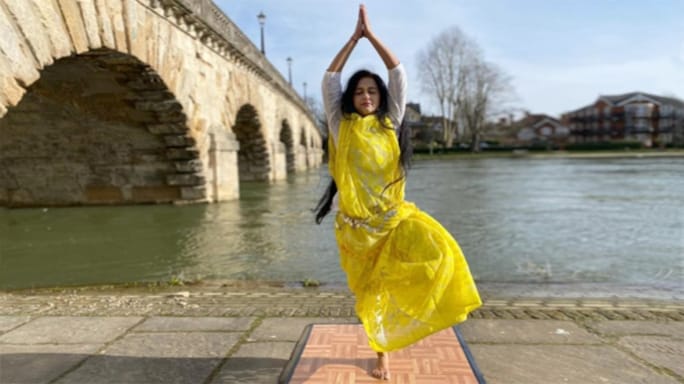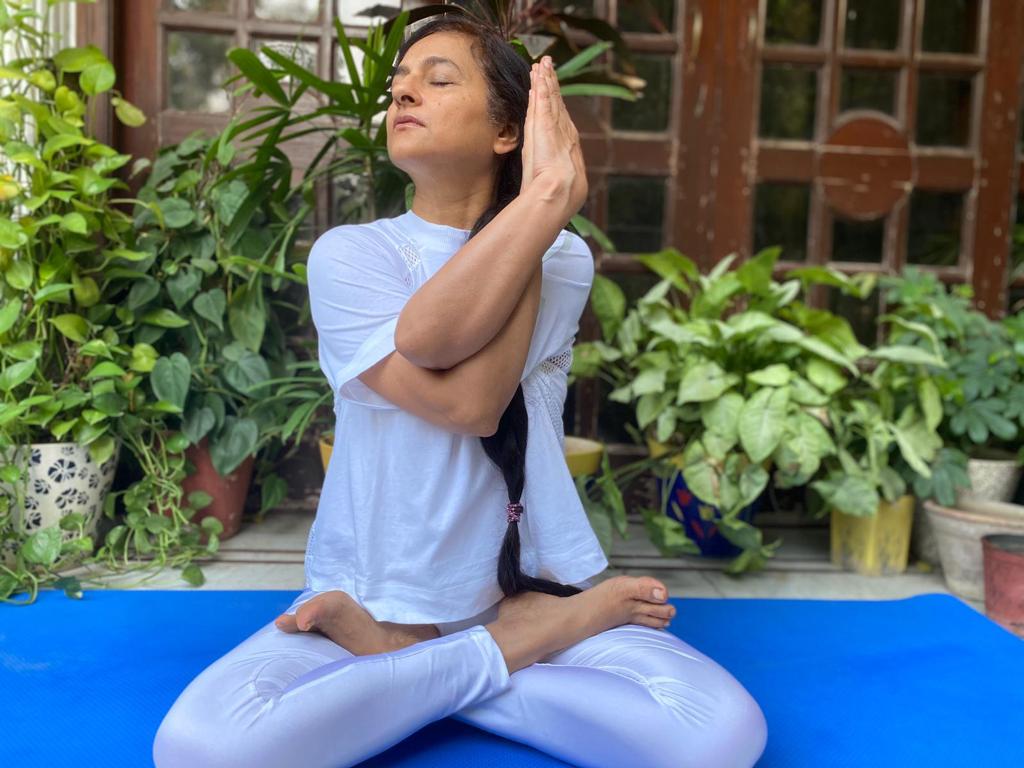- HOME
- /
- Health & Wellness
- /
- Yoga
- /
Towards Calmness In 30 Days
Dance partners with yoga in this unique fitness regimen
 Image Courtesy: Dahlia Sen Oberoi
Image Courtesy: Dahlia Sen Oberoi
It was a leap of faith for Dahlia Sen Oberoi, a well-known Intellectual Property Rights lawyer when she decided to take a break from her hectic work schedule and host of other responsibilities and opted for a hermetic life by enrolling herself in a teacher’s training course at an Ashram in South India.
Her month-long spiritual sojourn driven by the quest to connect with her inner self inspired her to pen down her experiences of discovering yoga, well into her 50s and discover her path to wellness in her debut novel, ‘Ashramed- From Chaos to Calm’ published by Hachette India last month. Once home, she not only continued training and teaching yoga but also took up her love for dancing and turned it into a passion project. She calls this marriage DahliaNritYog- an amalgamation between Indian classical dance, Kathak and yoga and recommends it to be a fun-filled fitness routine for all.
Q. From clocking long hours in the court and hustling hard to meet your career goals, you dived straight into the Ashram life of self-induced isolation that metamorphosed to sort of a ‘spiritual hibernation’ as mentioned in your book. How did the transformation pan out for you?
A. Absolutely, I think a good ending to my story would have been ‘… And then I stopped being a lawyer’. But that didn't happen. After I returned from the Ashram, I immediately jumped right back into the thick of things. It’s not that one has to necessarily mark attendance at an Ashram to achieve a transformational goal but the idea is to slow down and be cognizant of your state of being while learning a new skill that can make a difference in how you live. I spent that one month in the Ashram doing just that.
While doing yoga or any asana, especially a complicated one, channelizing one’s entire focus on the exercise helps in several ways. First, it improves concentration as you stop thinking about anything else and invest your mind solely into the craft. On top of that, practicing meditation has an undeniably calming effect.
Q. In your book you talk about various acts of cleansing bodily systems via purgation or performing kriyas, breathing exercises or chanting and also suggest these can free the mind and aid in emotional release. Could you elaborate on how that works?
A. Yes, these are great techniques to practice. But my suggestion would be not to try it on own without proper guidance. For instance, the Kunjal Kriya that entails drinking a lot of saline water and inserting two fingers into the back of the throat and throwing up to clear out the digestive tract needs to be learnt first in order to perform it. So are Jal neti and Sutra neti in which you take water and string respectively from the nostril and push it out from the throat to clean the nasal passage. Having said that, they are easy to pick up and can be performed smoothly once taught by a trusted trainer or an experienced source. Our bodies and minds are stronger than we think. However, a word of caution for those with specific body issues or co-morbidities to get medical advice before getting into any of these exercises.
 In frame: Dahlia Sen Oberoi
In frame: Dahlia Sen Oberoi
Q.Your book describes some of the yoga techniques you picked up in great detail. Do you believe the elaborate process works well for those on the go or is there a need to repackage them into something more achievable or sustainable?
A. There’s no clear answer to it because I feel that if we’re healthy and more so, capable, then it’s best to stick to the practice the way it was created. The practice of yoga in itself is very scientific and purposeful which does not need any kind of tampering. However, it may be adjusted considerably for those with limitations such as spinal issues, hypertension or diabetes to suit their needs. A good example of this we were taught at the Ashram is ‘Chair Yoga’ for the elderly. Certain props or other variations may also be introduced to aid the process. But otherwise, it is advisable to sit on the floor and practice it.
Q. What are those diet or lifestyle changes that you would recommend along with practicing yoga? What are your thoughts on short-term workout options and health solutions influencing millennials big-time claiming faster results?
A.I think, again, this question emanates from the fact that we are all looking for quick fixes to everything in our lives. We live at a time where a social media reel is of 45 seconds because of our minimized attention span. As appealing as perfectly toned bodies may be, one has to understand that it’s far from reality. When we watch people breezing through demanding physical routines, it is probably because they’ve put in a lot of time and practice before performing it. Sometimes, there’s bit of camera trickery involved as well.
When it comes to food habits, it’s great if we can take out some time to cook our own meals or resort to simple, home-cooked food options. Put equal emphasis to all food groups such as proteins, fats, carbohydrates and sugar in our diet instead of giving into fads and use own judgement in making decisions when it comes to nutrition and fitness. A regimented exercise like yoga is always recommended but something like walking also helps a great deal.

Q.How much time do you think one should allot on a daily basis for yoga or any kind of exercise?
A. A minimum of 30 minutes needs to be dedicated to any kind of exercise, be it walking, yoga or going to the gym. Apart from that, contact with the floor is really beneficial whether you’re reading a book, watching TV or chopping vegetables because you’re exercising your knees and lower back when you’re moving to get up and settle down. Small habitual changes like being mindful of postures, keeping the spine erect and the shoulders straight can go a long way in making a difference.
Q.Your book is thoroughly humour laced. Did it help you convey the message of yoga and wellness better?
A. The humour in my book is not contrived at all. I try to see the sunny side of things and don’t take myself too seriously. So, when I wrote the book, I thought a little humour can help deliver the message of fitness and wellness without being too preachy. I wanted to share my experiences hoping these could benefit readers as much as it did to me.
 Ashramed- From Chaos to Calm by Dahlia Sen Oberoi, published by Hachette India
Ashramed- From Chaos to Calm by Dahlia Sen Oberoi, published by Hachette India
Q. Walk us through the brand of yoga you designed marrying Kathak and Yoga. How can one benefit from it?
A. I’ve learnt Kathak since the age of four but then life happened. I became a lawyer, and a mother and that passion took a backseat. So, a few years ago, when one of my clients—an acclaimed Kathak dancer asked about my fees, I saw a real opportunity to rekindle my interest in dance and requested her to guide me instead. In 2017, I went back on stage after a hiatus of 25 years. The various influences of folk dance and Bharatanatyam and later, yoga led me to design a fusion of dance and yoga and coin the term ‘DahliaNritYog’
Talking about benefits, dance and yoga both need balance and poise and are guided by a certain rhythm. The only difference is that yoga teaches you to be still, calm and tolerant whereas dance and especially Kathak involve intricate footwork and chakkars in which a lot of speed is attached. So, NritYoga offers one the required cardio while adding pep and music to the mix.






